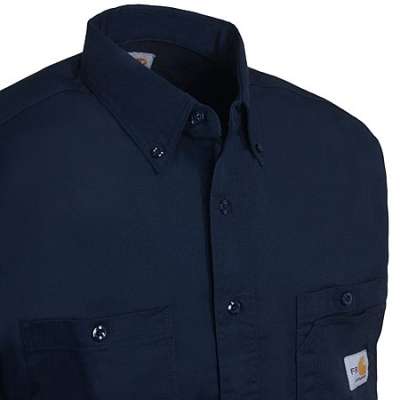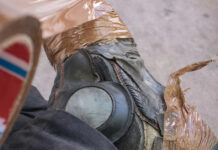Fabrics made from inherently FR fibers are known as synthetic fabrics and have a unique chemistry that makes them FR for the life of the garment. There are numerous fabrics that are comprised of inherently FR fibers. These fibers have been tested and are regulated in order to be approved as inherently FR fibers. Many inherently FR fabrics are known by a brand name, but not too worry, we will explain what exactly is in each fabric and what that means for you, the wearer, to make your decision on which inherently FR fibers will be the best to fulfill your FR apparel needs.
Cool Touch 2
Cool Touch 2 garments are a blend of Tecasafe plus a blended fabric of 48% modacrylic, 37% lyocell and 15% para-aramid. Cool Touch 2 is manufactured by Ten Cate and is very durable with the ability to retain moisture better than 100% aramid fabric. Cool Touch 2 is typically worn for the use of petrochemicals, by electrical workers and firefighters. It is not recommended for wear around molten substances or welding operations or for critical static environments. Because Cool Touch 2 is made with a blend of synthetic fibers, it is FR for the life of the garment. The lyocell fiber, however, is not treated for FR but its self-extinguishing characteristic is drawn from the presence of other fibers. Cool Touch 2 is extremely stable in high temperatures and will not melt. Cool Touch 2 should not be taken off or put on in hazardous conditions due to the risk of creating static charges. Caring for Cool Touch 2 is relatively easy. It should be washed in soft water with a low alkalinity surfactant based detergent. It is recommended to wash in cold temperatures to retain the shape of the garment. It may be necessary though, to wash in hot temperatures to remove hazardous soils. When drying the garments, use the permanent press option. Do not use chlorine bleach when laundering.
Glenguard FR
Glenguard FR is a trademark and manufactured by Glen Raven Technical Fabrics, LLC. The fabric is comprised of their blend of Kermel, which includes modacrylic and antistatic fibers. Glenguard can come in woven and knit constructions and has excellent strength and durability. It is inherently FR and has electric arc protection. Glenguard FR fabrics are worn by utility and transportation workers, professional firefighters and used for petrochemical oil and gas services. It should not be worn in environments with critical static control is needed and where there is exposure to molten metal substances or welding operations. The fabric is resistant to most bleaches, solvents and low acid concentrations, but will not provide wearers chemical protection. The fabric will not melt and is highly stable in high thermal conditions. Do not remove or put on the garment in hazardous areas. Caring for Glenguard FR fabrics is a little tricky. It must be washed in soft water but must be washing with the alkaline wash formula found in NFPA 2113 (Standard on Selection, Care, Use and Maintenance of flame-resistant Garment for Protection of Industrial Personnel Against Flash Fire). It may be dried on permanent press or medium setting.
Kermel Synthetic Polyamide Imide Aramid Fiber
Manufactured in France by Kermel, this fabric is a synthetic polyamide amide aramid fiber and is only made in fabrics blended with other fibers. It can be used with wool for dress uniforms, sweaters, and underwear or blended with high tenacity aramid for bunker gear and gloves. Kermel is also used by workers in petrochemicals, utilities and by professional firefighters. It is not recommended for environments with molten substances or welding operations or where there are critical static operations. Kermel is unique in that it can be made with a water-repellent finish to protect again chemical splashes and acid resistance. It does not, however, provide personal chemical protection for the wearer. Kermel should be washed in soft water and must not be laundered with chlorine bleach.
Nomex
Manufactured by DuPont, Nomex is a meta-aramid fiber used by wearers in petrochemicals, utilities, military applications, auto racing, and by volunteer and professional firefighters. It is sold as Nomex IIIA, which is a blend of 93% Nomex, 5% Kevlar and 2% static dissipative fiber. This blend that includes Kevlar is not to be used around molten substances or welding operations or in environments that require critical static control. Nomex does not provide chemical protection to the wearer and should be worn with specialized barrier garments. It is very durable and does not melt. Fibers begin to decompose between 700-800 degrees F. If using around molten substance, the hot molten will stick to the fiber and cause holes in the fabric. It should not be taken on or off in hazardous areas. When caring for Nomex wash in soft water in cold water with nonionic detergents. If desired, it can be washed at higher temperatures in harsher detergents, it will only affect the color and will not interfere with the FR performance.
PBI
PBI used alone or in a blend, PBI is a synthetic polybenzimidazole fiber. PBI Gold is a fabric blend of 60% Kevlar aramid and 40% PBI blend offered by PBI DIFCO and TenCate. PBI Gold is mostly used for professional firefighters turnout gear and other career apparel. It should not be used in environments that require critical static control. PBI is very resistant to solvents but loses strength with exposure to chlorine bleach. It does not provide chemical protection to the wearer and should be worn with specialized barrier garments. Additionally, PBI Gold does not melt and will not ignite. If it is exposed to molten substances, the fabric will start to pinhole. PBI retains moisture extremely well and actually exceeds cotton and rayon. Its moisture retention ability is equal to Nomex and other synthetic fabrics. When caring for PBI wash separately in soft water with a low alkaline, surfactant based detergent. The water pH should be 10.0 or lower. Do not use chlorine bleach, as it degrades the fabric.
Protera
Protera is manufactured by DuPont and is a synthetic fabric blend of 65% Modacrylic, 23% Nomex, 10% Kevlar and 2% static dissipative fiber. You can buy it in both shirt and pants weights, which are both very durable. Protera is typically used in petrochemical environments, by electrical workers and firefighters. It is not to be used around molten substances or welding operations or in environments that require critical static control. Protera is very resistant to solvents but loses strength with exposure to chlorine bleach. Additionally, it has great thermal stability and will not melt. When caring for Protera, keep a few things in mind. Wash the garments separately in a low alkalinity, surfactant based detergent in mild temperatures. Do not use chlorine bleach. When washing and drying garments, use the permanent press setting. Garments can be dry cleaned if desired.
Rainwear
Even in the rain, there may be an instance that involves exposure to dangerous flames or electric arcs. FR rainwear not only protects the wearing from rain and wind, but it also does not melt, drip or burn if exposed to flash fire or electric arcs. FR Rainwear is available in two forms, breathable and non-breathable fabrics. Most rainwear is a non-breathable fabric.
Non-Breathable Rainwear
Made of a single or double coating of Nomex substrate with FR polychloroprene, PVC or other waterproof, non-breathable substances. Be sure to look at the make of the material when purchasing though. Some garments are labeled FR but are actually comprised of nylon, which is inferior to Nomex.
Breathable Rainwear
Breathable rainwear fabric is made by combining a Nomex woven outer shell to a breathable polyurethane liner, making a two or three layer garment. Another way breathable rainwear is made is by combining the same outer Nomex shell to a knit or non-woven lining with a breathable PTFE membrane, also making a two or three layer garment.
Rainwear garments are used by electrical utility workers, oil and gas operations and other work environments that have a risk of thermal exposure in a wide range of climatic conditions. It is not to be used around molten substances or welding operations or in environments that require critical static control. FR Rainwear will not ignite or melt, however, if there is molten substance contact, the rainwear will begin to pinhole. When caring for your rainwear you should wipe the surface clean with a mild detergent water solution. It should be rinsed or machine-washed in warm water, using a mild detergent. Do not dry clean your rainwear.




